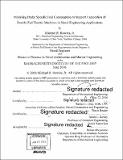Modeling brake specific fuel consumption to support exploration of doubly fed electric machines in naval engineering applications
Author(s)
Rowles, Jr., Michael R. , Jr
DownloadFull printable version (11.30Mb)
Other Contributors
Massachusetts Institute of Technology. Department of Mechanical Engineering.
Advisor
James L. Kirtley.
Terms of use
Metadata
Show full item recordAbstract
The dynamic operational nature of naval power and propulsion requires Ship Design and Program Managers to design and select prime movers using a much more complex speed profile rather than typical of commercial vessels. The inherently reduces the overall efficiency of the plant as operated in comparison to its potential. The fuel consumption of prime movers is a multi-variable function of power demand and rotational speed. Mechanically coupled power and propulsion arrangements constrain this two degree of freedom relationship by removing the independence of the speed parameter. Fixed frequency power generation requires a constant prime mover speed that has a narrow power band for optimal fuel consumption. Likewise, geared propulsion arrangements restrict the prime mover's speed to a dependence on the combined propulsor thrust-hull resistance performance which generally follows a cubic function. Optimal fuel consumption, however, involves matching the load's efficiency performance to that of the prime mover. This requires the rotational speed of the prime mover to be an independent variable with the freedom to adjust to the lowest specific fuel consumption for the demanded power. Variable frequency drive (VFD) concepts offer relief of this constraint but at a cost in the form of increased power conversion and control support system footprints. The ever increasing and complex demands for electrical power increases the motivation and interest in innovative technologies that improving current design concepts. Incorporating doubly fed electric machines (DFEM) into the power and propulsion design architecture enables the efficiency results of a VFD system but with a smaller conversion and control support footprint. The Navy has invested resources into research and development of several electric power and propulsion technologies enabling deployment of VFD systems on a handful of ship classes. The wind power generation industry has matured many aspects of DFEM technology. Leveraging this experience into naval engineering applications could help facilitate additional platform types and sizes to benefit from the operational advantages of integrated electrical architectures. Applying DFEM concepts to naval engineering requires a horizontal transfer of the body of knowledge. Researchers in the field of DFEM technology need to gain a better understanding of the intricacies of integrating a marine vessel's engineering plant with the vessel's designed purpose. New methods of analysis tailored specifically to marine power and propulsion require development for the technology to be properly assessed. This study outlines the various issues challenging ship designers and explains the manner in which DFEM research can be continued in naval engineering. Finally a method of examining a prime mover's fuel consumption is developed to provide a three-dimensional "fuel map" surface relationship of power-to-speed-to-fuel consumption. This thesis will serve as a building block supporting further DFEM power and propulsion concept analysis.
Description
Thesis: Nav. E., Massachusetts Institute of Technology, Department of Mechanical Engineering, 2016. Thesis: S.M. in Naval Architecture and Marine Engineering, Massachusetts Institute of Technology, Department of Mechanical Engineering, 2016. Cataloged from PDF version of thesis. Includes bibliographical references (pages [71a]-[71b]).
Date issued
2016Department
Massachusetts Institute of Technology. Department of Mechanical EngineeringPublisher
Massachusetts Institute of Technology
Keywords
Mechanical Engineering.